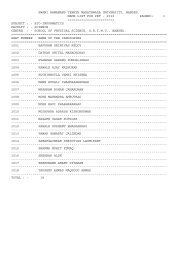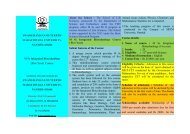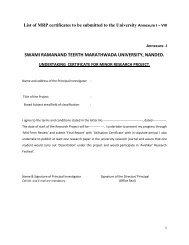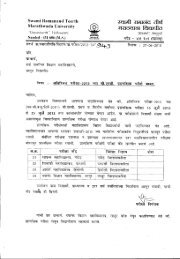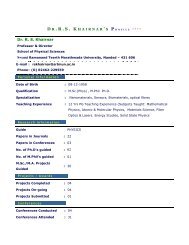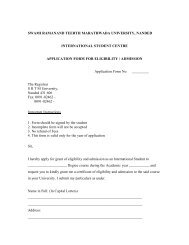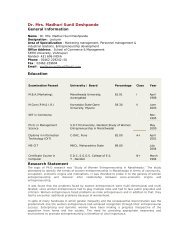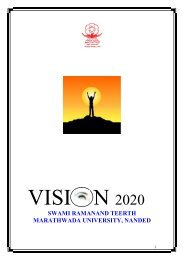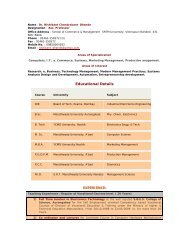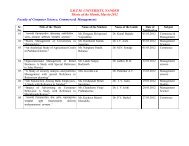Botany B.Sc I - The Swami Ramanand Teerth Marathwada University
Botany B.Sc I - The Swami Ramanand Teerth Marathwada University
Botany B.Sc I - The Swami Ramanand Teerth Marathwada University
Create successful ePaper yourself
Turn your PDF publications into a flip-book with our unique Google optimized e-Paper software.
SWAMI RAMANAND TEERTH MARATHWADA UNIVERSITY, NANDED<br />
B. <strong>Sc</strong>. GENERAL (SEMESTER PATTERN)<br />
B. <strong>Sc</strong>. FIRST YEAR<br />
BOTANY – CURRICULUM<br />
(MCQ Pattern)<br />
w. e. f. JUNE, 2011
INTRODUCTION<br />
Revising and updating of the curricula is the continuous process to provide an<br />
updated education to the students at large. Up till now there was wide diversity in the<br />
curricula of different Indian Universities which inhibited mobility of students in other<br />
universities or states. To ensure and have uniform curricula at UG and PG levels in<br />
different Indian Universities, the UGC developed a model curriculum and forwarded the<br />
same to all the universities in the country to serve as a base in updating their respective<br />
curricula.<br />
For developing the final draft of curriculum, the BOS in <strong>Botany</strong> took into account<br />
total number of teaching days available in a year and the guidelines given by the faculty<br />
of science of the S.R.T.M.U Nanded. <strong>The</strong> BOS in <strong>Botany</strong> held a couple of meetings in<br />
which there were thorough and critical discussions.<br />
S.R.T.M.U. Nanded is having B.<strong>Sc</strong>. (General) <strong>Botany</strong> course. <strong>The</strong> course content<br />
has been designed on semester pattern.<br />
<strong>The</strong> course content of each theory paper is divided into units and subunits by<br />
giving appropriate titles and subtitles. For each unit, total number of periods required and<br />
weightage of maximum marks is mentioned. At the end of each theory paper the list of<br />
selected reading material is provided. A list of practical exercises to be completed in the<br />
academic year is also given. Paper wise skeleton question paper is provided as a<br />
guideline to teachers, students and paper setters.<br />
***
OBJECTIVES<br />
1. To evolve uniform curricula in all the universities of the country and to provide<br />
mobility to students from one university or state to other<br />
2. To update curricula by introducing recent advances in the subject and enable the<br />
students to face NET, SET UPSC and other competitive examinations<br />
successfully.<br />
3. To create awareness among the students about the botany and train them in the<br />
subject.<br />
4. To improve the quality of laboratory and field work, for which study tours and<br />
excursions have been made compulsory so that the students can become familiar<br />
with the flora and ecosystems of that area.<br />
5. To prepare such a dynamic curricula by incorporating innovative concepts and a<br />
multidisciplinary approach which can attract and develop interest among the<br />
students for selecting plant science as their career.<br />
***
CURRICULUM DESIGNING COMMITTEE<br />
1. Dr.Bodke S.S. Chairman<br />
Yeshwant Mahavidyalaya, Nanded<br />
2. Dr. Kadam A.S. Member<br />
D.S.M. Mahavidyalaya, Jintur<br />
3. Dr. Mandge S.V. Member<br />
Shri. SGM College, Loha<br />
4. Dr. Gawai D.U. Member<br />
<strong>Sc</strong>ience College, Nanded<br />
5. Dr. Dakore H.G. Member<br />
P.N.College, Nanded<br />
6. Dr. Aithal S.V. Member<br />
Vai. D.M.Mahavidyalaya, Degloor<br />
7. Dr. Biradar S.D. Member<br />
D.S.M.College, Parbhani<br />
8. Dr. Bhadraiah B. Member<br />
Osmania <strong>University</strong>, Hyderbad<br />
9. Dr. Patil D.A. Member<br />
SSVP’s Dr. Ghogre <strong>Sc</strong>ience College, Dhule<br />
10. Dr. Mukadam D.S. Member<br />
Green Gold seeds Ltd., Walunj<br />
11. Dr. Gacche R.N. Member<br />
SRTM <strong>University</strong>, Nanded
SWAMI RAMANAND TEERTH MARATHWADA UNIVERSITY, NANDED<br />
B. <strong>Sc</strong>. GENERAL (SEMESTER PATTERN)<br />
B. <strong>Sc</strong>. FIRST YEAR<br />
BOTANY – CURRICULUM<br />
(MCQ Pattern)<br />
An Outline:<br />
Semester Paper No. & Title Period<br />
Marks<br />
/practi MCQ Internal Total<br />
cal Exam. Exam.<br />
Semester-I <strong>The</strong>ory Paper-I: Diversity of<br />
Microbes<br />
45 40 10 50<br />
<strong>The</strong>ory Paper-II: Histology and<br />
Anatomy<br />
45 40 10 50<br />
Semester-II <strong>The</strong>ory Paper-III: Diversity of 45 40 10 50<br />
Cryptogams<br />
<strong>The</strong>ory Paper-IV: Embryology of<br />
angiosperms and Environmental<br />
biology<br />
Annual pattern Practical Paper-V: Practical based<br />
on theory papers of semester-I&II<br />
Workload:<br />
1. <strong>The</strong>ory: Per paper per week three periods<br />
2. Practical: Per batch per week one practical (Three periods)<br />
45 40 10 50<br />
24 - - 100
SWAMI RAMANANAD TEERTH MARATHWADA UNIVERSITY, NANDED<br />
B.<strong>Sc</strong>. First Year<br />
Semester - I<br />
(MCQ Pattern)<br />
BOTANY<br />
<strong>The</strong>ory Paper-I: Diversity of Microbes<br />
(Viruses, Bacteria, Fungi and Lichens)<br />
Periods – 45 Maximum Marks – 50<br />
________________________________________________________________________<br />
UNIT – I: VIRUSES (10 periods)<br />
1. General characters of viruses<br />
2. Classification of viruses based on host.<br />
3. Ultra structure of TMV<br />
4. Symptoms of viral diseases of plants<br />
5. Yellow vein mosaic of Bhendi<br />
6. Bean mosaic<br />
7. Transmission of viruses<br />
8. Economic importance of viruses<br />
UNIT – II: BACTERIA (10 periods)<br />
1. General characters of bacteria<br />
2. Ultra structure of bacterial cell<br />
3. Asexual reproduction (By binary fission and endospore formation) in bacteria<br />
4. Sexual reproduction (By conjugation) in bacteria<br />
5. Salient features of cyanobacteria<br />
6. Systematic position, habitat, distribution, structure and reproduction in Nostoc<br />
7. Role of bacteria and cyanobacteria in agriculture<br />
8. Archaebacteria – Introduction and Forms<br />
UNIT – III: FUNGI (12 periods)<br />
1. General characters of Fungi<br />
2. Classification of Fungi (as per Alexopolous and Mims,1979)<br />
3. Systematic position, occurrence, structure of mycelium, asexual reproduction,<br />
sexual reproduction and graphic life cycle of following fungal types<br />
i. Mastigomycotina – Albugo<br />
ii. Ascomycotina – Eurotium<br />
UNIT – IV: FUNGI AND LICHENS (13 periods)<br />
1. Systematic position, occurrence, structure of mycelium, asexual reproduction,<br />
sexual reproduction and graphic life cycle of following fungal types<br />
iii. Basidiomycotina – Agaricus<br />
iv. Deuteromycotina – Cercospora (Tikka disease of groundnut)<br />
2. Role of fungi in fermentation industries (Bakery and Brewery)<br />
3. General characters of lichens<br />
4. Types of lichens<br />
5. Economic importance of lichens
SELECTED READINGS (PAPER – I)<br />
1. Bodke S.S. and N.M. Diversity of Microbes and<br />
Dhekle (2007)<br />
Cryptogams<br />
2. Vashishta B.R. (1990) <strong>Botany</strong> for Degree Students<br />
Part-II Fungi<br />
3. Alexopolous C.J. & C.W.<br />
Mims (1979)<br />
Mansi prakashan, Nanded<br />
S. Chand & Co. New Delhi.<br />
Introductory Mycology Wiley Eastern Ltd.,<br />
New Delhi<br />
4. Smith G.M. (1971) Cryptogamic <strong>Botany</strong> Vol-I.<br />
Algae and Fungi<br />
Tata McGraw Hill<br />
Publishing Co. New Delhi.<br />
5. Dubey H.C. (1990) An Introduction to Fungi Vikas Publishing House,<br />
New Delhi.<br />
6. Sharma P.D. (1995) <strong>The</strong> Fungi Rastogi & Co., Meerut.<br />
7. Sharma O.P. (1992) A Text Book of<br />
Thallophytes<br />
8. Mehrotra R.S. and<br />
K.R.Aneja (1990)<br />
9. Pandey S.N.,P.S. Trivedi<br />
and S.P. Mishra<br />
Introduction to Mycology<br />
A Text Book of <strong>Botany</strong><br />
Vol-I & II<br />
10. Pandey B.P. (2000) College <strong>Botany</strong> Vol-I<br />
(Algae, Fungi, Bryophytes)<br />
Tata McGraw Hill<br />
Publishing Co. New Delhi.<br />
Wiley Eastern Ltd.<br />
New Delhi.<br />
Vikas Publishing House,<br />
New Delhi.<br />
S. Chand & Co. New Delhi.<br />
11. Clintion A (1958) Introduction to Bacteria McMillan, New York.<br />
12. Dubey H.C. (1982) Text Book of Fungi,<br />
Bacteria and Viruses<br />
13. Webster John (1980)<br />
14. Bodke S.S. and N.M.<br />
Dhekle (2009)<br />
Introduction to Fungi<br />
Cryptogamic <strong>Botany</strong><br />
Vikas Publishing House,<br />
New Delhi.<br />
Cambridge <strong>University</strong><br />
Press.<br />
Sanket Prakashan, Nanded
SWAMI RAMANANAD TEERTH MARATHWADA UNIVERSITY, NANDED<br />
B.<strong>Sc</strong>. First Year<br />
Semester - I<br />
(MCQ Pattern)<br />
BOTANY<br />
<strong>The</strong>ory Paper-II: Histology and Anatomy<br />
Periods – 45 Maximum Marks – 50<br />
________________________________________________________________________<br />
UNIT – I: MERISTEM (10 periods)<br />
1. Meristem and its classification based on position and origin<br />
2. Organization of root and shoot apices<br />
i. Apical cell theory<br />
ii. Histogen theory<br />
iii. Tunica carpus theory<br />
iv. Korper – Kappe theory<br />
UNIT – II: TISSUES (13 periods)<br />
Sub-Unit – I: Simple Tissues<br />
1. Parenchyma (Arenchyma, Chlorenchyma)<br />
2. Collenchyma<br />
3. <strong>Sc</strong>lerenchyma<br />
Sub-Unit – II: Complex Tissues<br />
1. Xylem<br />
2. Phloem<br />
Sub-Unit – III: Secretary Tissues<br />
A. Laticiferous Tissues<br />
1. Latex cells<br />
2. Latex vessels<br />
B. Glandular Tissues<br />
a. External glands<br />
1. Glandular hairs<br />
2. Stinging hairs<br />
3. Digestive glands<br />
4. Nectary glands<br />
b. Internal glands<br />
1. Oil glands<br />
2. Resin duct<br />
3. Hydathode<br />
UNIT – III: PRIMARY STRUCTURES (12 periods)<br />
1. Root anatomy of dicotyledons and monocotyledons (Sunflower and Maize)
2. Stem anatomy of dicotyledons and monocotyledons (Sunflower and Maize)<br />
3. Leaf anatomy of dicotyledons and monocotyledons (Sunflower and Maize)<br />
UNIT – IV: SECONDARY AND ANOMALOUS SECONDARY GROWTH<br />
(10 periods)<br />
1. Secondary growth in Sunflower root and stem<br />
2. Anomalous secondary growth in Dracaena stem<br />
3. Anomalous secondary growth in Achyranthus stem<br />
4. Anomalous secondary growth in Beet root<br />
SELECTED READINGS<br />
1. Sundara Rajan (1998)<br />
2. Dutta A.C. (1968)<br />
3. Tayal M.S. (1983)<br />
4. Ganguli, Das,<br />
Dutta(1981)<br />
5. Pandey B.P. (1993)<br />
10. Bodke S.S. and N.M.<br />
Dhekle (2009)<br />
College <strong>Botany</strong><br />
Vol-1 and Vol-2<br />
A <strong>Botany</strong> for Degree<br />
Students<br />
Plant Anatomy,<br />
Embryology and Ecology<br />
Himalaya Publication<br />
House, Nagpur.<br />
Oxford Press, Londan.<br />
Plant Anatomy Rastogi Publication, Meerut.<br />
College <strong>Botany</strong><br />
Vol-1 and Vol-2<br />
New Cenral Book Agency,<br />
Kolkatta.<br />
Plant Anatomy S. Chand & Co. Pvt. Ltd.<br />
6. Fahn A (1967) Plant Anatomy<br />
7. Singh V, Pande P.C.<br />
D.K. Jain (1994)<br />
Anatomy of Seed Plants Rastogi Publication, Meerut.<br />
8. Esau K. (1977)<br />
9. Earnes A.J. &<br />
L.H.MacDaniel (1947)<br />
Anatomy of Seed Plants John Wilex & sons,<br />
New York.<br />
Introduction to Plant<br />
Anatomy<br />
Mc Graw Hill Book Co.<br />
New York.<br />
Sanket Prakashan, Nanded
SWAMI RAMANANAD TEERTH MARATHWADA UNIVERSITY, NANDED<br />
B.<strong>Sc</strong>. First Year<br />
Semester - II<br />
(MCQ Pattern)<br />
BOTANY<br />
<strong>The</strong>ory Paper-I: Diversity of Cryptogams<br />
(Algae, Bryophytes and Pteridophytes )<br />
Periods – 45 Maximum Marks – 50<br />
________________________________________________________________________<br />
UNIT – I: ALGAE –I (10 periods)<br />
1. General characters of algae<br />
2. Classification of algae(As per F.E.Fritsch,1935)<br />
3. Systematic position, occurrence, thallus structure, vegetative reproduction,<br />
asexual reproduction, sexual reproduction and graphic life cycle with alternation<br />
of generation of the following algal types<br />
i. Chlorophyceae – Oedogonium<br />
ii. Xanthophyceae – Botrydium<br />
UNIT – II: ALGAE-II (10 periods)<br />
1. Systematic position, occurrence, thallus structure, vegetative reproduction,<br />
asexual reproduction, sexual reproduction and graphic life cycle with alternation<br />
of generation of the following algal types<br />
i. Phaeophyceae – Ectocarpus<br />
ii. Rhodophyceae - Batrachospermum<br />
2. Economic importance of algae (Food and fodder)<br />
UNIT – III: BRYOPHYTES (12 periods)<br />
1. General characters of bryophytes<br />
2. Classification of bryophytes (As per N.S.Parihar)<br />
3. Systematic position, occurrence, thallus structure(external and internal),<br />
vegetative reproduction, asexual reproduction, sexual reproduction and graphic<br />
life cycle with alternation of generation of the following types (Developmental<br />
stages not expected)<br />
i. Hepaticopsida – Riccia<br />
ii. Anthocerotopsida – Anthoceros<br />
iii. Bryopsida - Funaria<br />
UNIT – IV: PTERIDOPHYTES (13 periods)<br />
1. General characters of Pteridophytes<br />
2. Classification of Pteridophytes (as per N.S.Parihar)
3. LYCOPODIUM<br />
i. Systematic position<br />
ii. Occurrence<br />
iii. External features of sporophyte<br />
iv. Internal structure of stem<br />
v. Structure of strobilus<br />
vi. Structure of sporangium<br />
vii. Structure of spore<br />
viii. Structure of prothallus (L.complanatum type)<br />
ix. Sexual reproduction<br />
x. Graphic life cycle with alternation of generation<br />
(Developmental stages not expected)<br />
4. EQUISETUM<br />
i. Systematic position<br />
ii. Occurrence<br />
iii. External features of sporophyte<br />
iv. Internal structure of aerial stem (T.S of internode)<br />
v. Structure of strobilus<br />
vi. Structure of sporangiophore<br />
vii. Structure of sporangium<br />
viii. Structure of spore<br />
ix. Structure of prothallus<br />
x. Sexual reproduction<br />
xi. Graphic life cycle with alternation of generations<br />
(Developmental stages not expected)<br />
5. MARSILEA<br />
i. Systematic position<br />
ii. Occurrence<br />
iii. External features of sporophyte<br />
iv. Internal structure of petiole<br />
v. External structure of sporocarp<br />
vi. Structure of sorus (VLS)<br />
vii. Structure of microsporangium<br />
viii. Structure of megasporangium<br />
ix. Structure of microspore<br />
x. Structure of megaspore<br />
xi. Germination of microspore(formation of male gametophyte)<br />
xii. Germination megaspore (formation of female gametophyte)<br />
xiii. Graphic life cycle with alternation of generations<br />
(Developmental stages not expected)
SELECTED READINGS (PAPER – I)<br />
1. Vashishta B.R. (1990) <strong>Botany</strong> for Degree Students<br />
Part-I Algae<br />
2. Smith G.M. (1971) Cryptogamic <strong>Botany</strong> Vol-I.<br />
Algae and Fungi<br />
3. Smith G.M. (1971) Cryptogamic <strong>Botany</strong> Vol-II<br />
Bryophytes and<br />
Pteridophytes<br />
4. Sharma O.P. (1992) A Text Book of<br />
Thallophytes<br />
5. Vashishta B.R. (1990) <strong>Botany</strong> for Degree Students<br />
Part-III Bryophyta<br />
S. Chand & Co. New Delhi.<br />
Tata McGraw Hill<br />
Publishing Co. New Delhi.<br />
Tata McGraw Hill<br />
Publishing Co. New Delhi.<br />
Tata McGraw Hill<br />
Publishing Co. New Delhi.<br />
S. Chand & Co. New Delhi.<br />
6. Puri P. (1980) Bryophyta Atmaram & Sons. New<br />
Delhi.<br />
7. Parihar N.S. (1965) An Introduction to<br />
Embryophyta Vol-I<br />
Bryophyta<br />
8. Vashishta P.C. (1991) <strong>Botany</strong> for Degree Students<br />
Part-V Vascular<br />
Cryptogams (Pteridophyta)<br />
9. Parihar N.S. (1965) An Introduction to<br />
Embryophyta Vol-II<br />
Pteridophyta<br />
10. Sharma O.P. (1992) A Text Book of<br />
Pteridophytes<br />
11. Fritsch F.E.(1945) <strong>The</strong> Structure and<br />
Reproduction of Algae Vol-<br />
I & II.<br />
12. Chapman V.J. and D.J.<br />
Chapman (1962)<br />
13. Bodke S.S. and N.M.<br />
Dhekle (2009)<br />
14. Pandey S.N.,P.S. Trivedi<br />
and S.P. Mishra<br />
<strong>The</strong> Algae, English<br />
Language Book Society<br />
Central Book Depot,<br />
Allahabad.<br />
S. Chand & Co. New Delhi.<br />
Central Book Depot,<br />
Allahabad.<br />
McMillan (India) Ltd.<br />
Cambridge <strong>University</strong><br />
Press.<br />
McMillan, London.<br />
Cryptogamic <strong>Botany</strong> Sanket Prakashan, Nanded<br />
A Text Book of <strong>Botany</strong><br />
Vol-I & II<br />
Vikas Publishing House,<br />
New Delhi.
15. Pandey B.P. (2000) College <strong>Botany</strong> Vol-I<br />
(Algae, Fungi, Bryophytes)<br />
16. Pandey B.P. (2000) College <strong>Botany</strong> Vol-II<br />
(Pteridophyta,<br />
Gymnosperms,<br />
Paleobotany)<br />
S. Chand & Co. New Delhi.<br />
S. Chand & Co. New Delhi.<br />
17. Clintion A (1958) Introduction to Bacteria McMillan, New York.<br />
18. Bower F.O. (1988) Primitive Land Plants<br />
Vol-I & II<br />
19. Gangule H.C. & Kar<br />
A.K. (1995)<br />
Arihant Publishers, Jaipur.<br />
College <strong>Botany</strong> Vol-II New Central Book Agency,<br />
Calcutta.<br />
20. Rajan S. Sundra (1995) College <strong>Botany</strong> Vol-I & II Himalaya Publication<br />
House.<br />
21. Rajan S. Sundra (1995) College <strong>Botany</strong> Vol-I & II Himalaya Publication<br />
House.<br />
22. Saxena A.K.& Sarabhai<br />
R.P. (1968)<br />
23. Saxena A.K. & Sarabhai<br />
R.P. (1968)<br />
24. Rashid A (1976) An Introduction to<br />
Pteridophyta<br />
Text Book of <strong>Botany</strong> Vol-I Ratan Prakashan Mandir,<br />
Agra.<br />
Text Book of <strong>Botany</strong> Vol-II Ratan Prakashan Mandir,<br />
Agra.<br />
Vikas Publishing House,<br />
New Delhi.<br />
25. Rajan S. Sundra (1995) College <strong>Botany</strong> Vol-I & II Himalaya Publication<br />
House.<br />
26. Gupta J.S. (1987) Text Book of Algae Oxford & IBH Publ.<br />
New Delhi.<br />
27. Kumar H.D. &<br />
Singh H.N.(1990)<br />
28. Bodke S.S. and N.M. Diversity of Microbes and<br />
Dhekle (2007)<br />
Cryptogams<br />
29. Sporne K.R. (1976) <strong>The</strong> Morphology of<br />
Pteridophytes<br />
Text Book of Algae Affiliated East & West<br />
Publication, New Delhi.<br />
Mansi prakashan, Nanded<br />
B.I. Publication, Bombay.<br />
30. Vashishta P.C. (1988) <strong>Botany</strong> for Degree Students S. Chand & Co. New Delhi.
-Pteridophyta<br />
31. Parihar N.S. (1965) An Introduction to<br />
Embryophyta<br />
Vol-I Bryophyta<br />
32. Watson E.V. (1974) <strong>The</strong> Structure & Life of<br />
Bryophyta<br />
33. Dubey H.C. (1982) Text Book of Fungi,<br />
Bacteria and Viruses<br />
Central Book Depot,<br />
Allahabad.<br />
B.I. Publication, Bombay.<br />
Vikas Publishing House,<br />
New Delhi.<br />
34. Webster John (1980) Introduction to Fungi Cambridge <strong>University</strong><br />
Press.
SWAMI RAMANANAD TEERTH MARATHWADA UNIVERSITY, NANDED<br />
B.<strong>Sc</strong>. First Year<br />
Semester - II<br />
(MCQ Pattern)<br />
BOTANY<br />
<strong>The</strong>ory Paper-I: Embryology of Angiosperms and Environmental Biology<br />
Periods – 45 Maximum Marks – 50<br />
________________________________________________________________________<br />
UNIT – I: EMBRYOLOGY –I (10 periods)<br />
1. Introduction<br />
2. Structure of a Microsporangium(T.S. of anther)<br />
3. Structure of a pollen grain<br />
4. Development of male gametophyte (Microgametogenesis)<br />
5. Types of ovule<br />
6. Structure of anatropous ovule (L.S.)<br />
UNIT – II: EMBRYOLOGY –II (10 periods)<br />
1. Development of female gametophyte (Megagametogenesis)– Monosporic<br />
(Polygonum), Bisporic (Allium) and Tetrasporic (Adoxa)<br />
2. Double fertilization and its significance<br />
3. Development and maturation of seed (Post fertilization changes)<br />
4. Endosperm and its types<br />
5. Development of dicotyledonous embryo (Crucifer type)<br />
UNIT – III: ECOLOGY (13 periods)<br />
1. Ecology – Definition and <strong>Sc</strong>ope<br />
2. Structure of ecosystem (Abiotic and Biotic)<br />
3. Types of ecosystem (Pond ecosystem and Grassland ecosystem)<br />
4. Ecological pyramids and energy flow<br />
5. Food chain and Food web<br />
6. Morphological and anatomical adaptations of plants to water stress conditions<br />
iii. Hydrophytes – Hydrilla stem and Nymphea (Lotus) petiole<br />
iv. Xerophytes – Nerium leaf and Casuarina stem<br />
UNIT – IV: ENVIRONMENTAL BIOLOGY (12 periods)<br />
1. Pollution: Causes and effects of water, soil and air pollution and their control<br />
measures<br />
2. Aforestation and deforestation<br />
3. Chipko movement
SELECTED READINGS (PAPER – II)<br />
1. Trivedi R.K. etal (1987) Practical methods in<br />
Ecology &<br />
Environmental <strong>Sc</strong>ience<br />
Enviro Media Publishers<br />
Karad.<br />
2. Rao K.S. (1993) Practical Ecology Anmol Publication,<br />
Jodhpur.<br />
3. Odum E.P. (1971) Fundamentals of Ecology W.B. Saunders Co.<br />
Philadelphia.<br />
4. Shukla R.S. & Chandel<br />
P.S. (2000)<br />
5. Pandey B.P. (2003) Embryology of<br />
Angiosperms<br />
6. Saxena A.K. & R.P. A Text Book of <strong>Botany</strong><br />
Sarabhai (1975) Vol-2 Embryophyta<br />
7. Pande O.N., A. Chanda<br />
(1993)<br />
Plant Ecology S. Chand & Co. Pvt. Ltd.<br />
New Delhi<br />
A Text Book of <strong>Botany</strong><br />
Vol-3<br />
S. Chand & Co. Pvt. Ltd.<br />
New Delhi<br />
Kitab Ghar, Gwaliar<br />
Pergamon Press, Oxford.<br />
Vikas Publication House<br />
Pvt. Ltd., New Delhi<br />
8. Nebel B.J. (1990) Environmental <strong>Sc</strong>ience Printice Hall ind. Pvt. Ltd.<br />
New Delhi.<br />
9. Ravan P.H.,L.R. Berg,<br />
H.B. Johnson (1993)<br />
10. Andrew Goudie (1984) <strong>The</strong> Nature of the<br />
Environment<br />
11. Maheshwari P. (1972)<br />
12. Bhojwani S.S.<br />
Bhatnager S.P. (1974)<br />
13. Dwivedi J.N. (2000)<br />
Environment Saunder’s College Publi.<br />
New York.<br />
An Introduction to<br />
Embryology of<br />
Angiosperms<br />
Embryology of<br />
Angiosperms<br />
Embryology of<br />
Angiosperms<br />
Basil Blackwell Cambridge,<br />
U.S.A.<br />
Tata Mc Graw Hill Book<br />
Pub. Co. Ltd. New York.<br />
Vikas Publication House<br />
Pvt. Ltd., New Delhi.<br />
14. Agarwal K.C. (1993) Environmental Biology Agro botanical Publishers,<br />
Jodhpur.<br />
15. Mishra K.C. (1992) Manual of Plant Ecology Oxford & IBH Publi. Co.
Pvt. Ltd. New Delhi.<br />
16. Khochar P.L. (1980) Plant Ecology S. Nagin & Co. Jallundhar.<br />
17. Kormandi E.J. (1984) Concepts of Ecology Printice Hall ind. New<br />
Delhi.<br />
18. Asthana R.K. (1998) Environmental Problems<br />
and Solutions<br />
19. Verma P.S., V.K.<br />
Agarwal (1983)<br />
20. Subramanyam N.S.<br />
A.V.S.S. Sambmurthy<br />
(2000)<br />
21. Sharma O.P. (1993) Ecology &<br />
Environmental Biology<br />
21. Bodke S.S. and N.M.<br />
Dhekle (2009)<br />
S. Chand & Co. Pvt. Ltd.<br />
New Delhi.<br />
Environmental Biology S. Chand & Co. Pvt. Ltd.<br />
New Delhi<br />
Ecology Narosa Publishing House,<br />
New Delhi.<br />
Plant Anatomy,<br />
Embryology and Ecology<br />
Rastogi Publication, Meerut.<br />
Sanket Prakashan, Nanded
SWAMI RAMANAND TEERTH MARATHWADA UNIVERSITY, NANDED<br />
B. <strong>Sc</strong>. FIRST YEAR<br />
BOTANY<br />
Practical Paper-V: Practical based on theory papers of Semester-I<br />
& Semester-II)<br />
Practicals: 24 Marks: 100<br />
________________________________________________________________________<br />
Practical 1: Preparation of culture media- PDA/NA<br />
Practical 2: Study of yellow vein mosaic of bhendi and bean mosaic disease<br />
Practical 3: Study of morphology of bacteria by Grams staining method<br />
Practical 4: Study of external features of Nostoc (Cyanobacterium)<br />
Practical 5: Study of external features of Albugo and Eurotium with<br />
classification<br />
Practical 6: Study of external and internal characters of Agaricus and Cercospora<br />
Practical 7: Study of types of Lichens (Crustose, Foliose and Fructicose)<br />
Practical 8: Study of external features of Oedogonium and Botrydium with<br />
classification<br />
Practical 9: Study of external features of Ectocarpus and Batrachospermum with<br />
classification<br />
Practical 10: Study of external and internal features of Riccia and Anthoceros<br />
Practical 11: Study of external and internal features adult gametophyte of Funaria<br />
Practical 12: Study of external features of adult sporophyte and internal structure (T.S.)<br />
of stem of Lycopodium and Equisetum<br />
Practical 13: Study of external features of adult sporophyte and internal structure (T.S.)<br />
of stem and petiole of Marsilea<br />
Practical 14: Study of meristematic and permanent tissues with the help of permanent<br />
slides/models/ charts/photocopies<br />
Practical 15: Study of secretary tissues with the help of permanent slides/models/<br />
charts/photocopies<br />
Practical 16: Preparation of double stained permanent slides of Maize and Sunflower<br />
stem<br />
Practical 17: Preparation of double stained permanent slides of Dracaena stem and Beet<br />
root<br />
Practical 18: Study of T.S. of Anther and L.S. of Ovule<br />
Practical 19: Study of types of ovule with the help of permanent slides/models/<br />
charts/photocopies<br />
Practical 20: Study of morphological and anatomical structures in Hydrophytes (Hydrilla<br />
stem and Nymphea petiole)<br />
Practical 21: Study of morphological and anatomical structures in Xerophytes (Nerium<br />
leaf and Casuarina stem)<br />
Practical 22 – 24: Botanical excursions (two short and one long)
SKELETON OF QUESTION PAPER<br />
B. <strong>Sc</strong>. FIRST YEAR<br />
BOTANY<br />
Practical Paper-V: Practical based on theory papers of Semester-I<br />
& Semester-II)<br />
Time: 4 Hours Marks: 100<br />
________________________________________________________________________<br />
Date: Session: Batch No.:<br />
________________________________________________________________________<br />
Note: 1. Draw neat and well labeled diagram wherever necessary<br />
2. Show your preparation to the examiner<br />
________________________________________________________________________<br />
Q1. Identify, classify and describe the given specimen A (Fungi) on the basis of<br />
external and internal characters 10<br />
Q2. Identify, classify and describe the any two algae from the given mixture on the<br />
basis of external and internal characters 10<br />
Q3. Identify, classify and describe the given specimen B (Bryophytes /<br />
Pteridophytes) on the basis of external and internal characters 15<br />
Q4. Make double stained permanent preparation of Maize stem/Sunflower<br />
stem/Dracaena stem/Achyranthus stem/Beet root 15<br />
Q5. Make temporary preparation of given specimen. Identify and describe ecological<br />
adaptations on the basis of anatomical peculiarities 15<br />
Q6. Spotting (Five) 15<br />
(Viruses / Bacteria / Lichens-1, Bryophyta / Pteridopyta- 1, Histology- 1,<br />
Anatomy -1 and Embryology -1)<br />
Q7. i. Record book 10<br />
ii. Submission 10



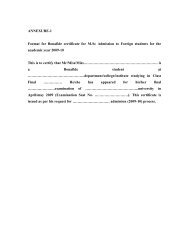

![Lokeh jkekuan rhFkZ ejkBokMk fo|kihB] ukan sM - - The Swami ...](https://img.yumpu.com/26553812/1/190x245/lokeh-jkekuan-rhfkz-ejkbokmk-fo-kihb-ukan-sm-the-swami-.jpg?quality=85)
